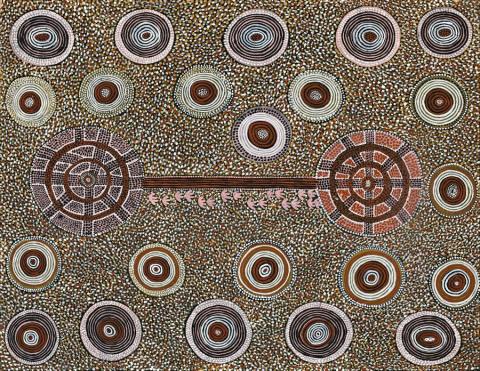KUNINGKA, 1973
ANATJARI NO. III TJAKAMARRA
synthetic polymer powder paint on composition board
61.0 x 79.0 cm
inscribed verso: title, Papunya Tula
Artist cat. A731078, and a large annotated diagram in Peter Fannin's hand on the reverse
Probably painted at Yai-yai, the Pintupi outstation in October 1973
Papunya Tula Artists, Alice Springs
Sotheby's, Melbourne, 9 July 2001, lot 113
Private collection, Melbourne
The original documentation accompanying this painting was recorded by Peter Fannin who had succeeded Geoffrey Bardon as the manager of Papunya Tula Artists. It identifies the subject as being the ancestral echidna or porcupine traveling between a cave near the present day Pintupi settlement of Walungurru (Kintore) to another in the east, as represented by the two large circles. The ceremonial associations of the work are indicated by the concentric roundels that refer to a variety of ritual designs painted onto the bodies of ceremonial participants. According to the anthropologist Professor Fred Myers who carried out extensive fieldwork with the artist, the subject of this work may relate to the Tarkurrnga narrative that takes an ancestral echidna from near Angus Hills to the east. However, Myers suggests that it is probable that the word 'Kuningka' was incorrectly heard by Fannin as 'Echidna', as the main subject of this painting is Kuningka the Native Cat who is not usually associated with Walungurru, though the ancestor is said to have visited the site of Tikatika to the southeast.
Kuningka, 1973, relates to a later canvas by Anatjari about his major Dreamings: Big Map of Country, 1975, illustrated in Myers, F.R., Painting Culture: The Making of an Aboriginal High Art, Duke University Press, Durham and London, 2002, p. 105, pl. 4. This work connects the ancestral Native Cat to Kutungu the Snake Woman and a Tingarri man that is being chased by the Cat. Here, the Cat's tracks which traverse the canvas are drawn in a similar fashion to those joining the two larger roundels in Kuningka, 1973 (Myers, 2002, pp. 105-106).
Kuningka is a recurring theme in Anatjari's paintings, however Geoffrey Bardon describes the ancestor that bears this name as a 'kangaroo rat' or hopping mouse (Bardon, G., and Bardon, J., Papunya, A Place Made After the Story: The Beginnings of the Western Desert Painting Movement, The Miegunyah Press, Melbourne, 2004, pp. 454-457). Anatjari usually renders the subject in a series of square or rectangular motifs as in Rat Kangaroo Dreaming, c1974, in the collection of the Museum and Art Gallery of the Northern Territory, Darwin, and Rat Kangaroo Dreaming, 1972, in the collection of the Art Gallery of Western Australia, Perth, both illustrated in Perkins, H., and Fink, H. (eds), Papunya Tula: Genesis and Genius, Art Gallery of New South Wales in association with Papunya Tula Artists, Sydney, 2000, pp. 21 and 22 respectively; and 'Kuningka' Kangaroo Rat Dreaming (Version 3), 1973, illustrated in Bardon and Bardon, 2004, painting 430, p. 455.
